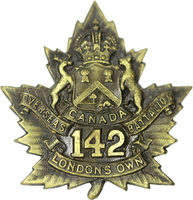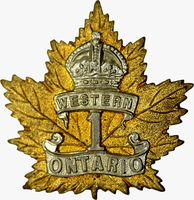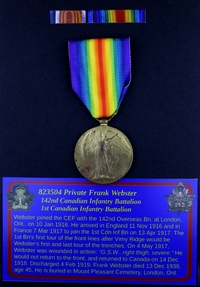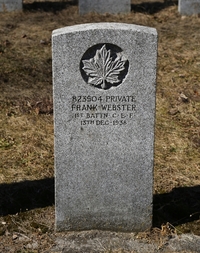
823504 Private Frank Webster
142nd Overseas Battalion, "London's Own"
1st Canadian Infantry Battalion
By: Capt (ret'd) Michael M. O'Leary, CD, The RCR
Frank Webster was born in Dorchester, Ontario, on 6 Jul 1892. Webster's family, led by parents Fred and Elizabeth, can be found in the 1901 Canadian Censuses. Frank is the middle child of three, with an older brother, William, and a younger sister, Minnie. Frank's mother, Elizabeth, would die in 1911.
Webster attested for service in the Canadian Expeditionary Force (C.E.F.) with the 142nd Overseas Battalion at London, Ont., on 10 Jan 1916. A 23-year-old teamster, Webster was described on his attestation paper as 5 feet 9 inches tall, weighing 170 pounds, with a 37-inch chest, a ruddy complexion, brown eyes, and brown hair. His religious denomination was Church of England. Webster identified his wife, Ellen, as his next of kin with an address of 220 Clarence St., London, Ont. By October, 1916, her address would change to 419 Ridout St, London, Ont. On attesting with the 142nd Battalion, Webster was given the regimental number 823504.
The 142nd (London's Own) Battalion was based in London, Ontario, and the unit began recruiting in late 1915 in that city. After sailing to England, the battalion was absorbed into the 23rd Reserve Battalion on 11 Nov 1916.
On 1 Feb 1916, while his unit was training at Wolseley Barracks in London, Ont., Frank Webster married Ellen James. Ellen was 23 years old and came from the town of Strathroy, Ont. The marriage was conducted at London, Ont.
A note in Webster's service record shows that he was away without leave from 19 to 27 Mar 1916. It does not, however, note what punishment he received. That punishment, however, apparently did not completely convince Webster to behave. In June 1916 he received 96 hours detention for breaking camp.
The 142nd Battalion sailed from Halifax on 31 Oct 1916 aboard the S.S. Southland. The unit arrived in England on 11 Nov 1916. Immediately on disembarkation, the unit was absorbed into the existing reinforcement system. Effective 12 Nov 1916, Webster was taken on strength of the 23rd Reserve Battalion at Dibgate.
Webster was admitted to the Military Hospital at Shornecliffe on 1 Dec 1916, diagnosed with "V.D.G.," i.e., venereal disease, gonorrhea. He was transferred to the Canadian Hospital at Etchinghill on 4 Dec 1916 and discharged from hospital on 19 Dec 1916. After 19 days for treatment of venereal disease, Webster's pay account would be debited $11.40, this was the loss of half his pay, 50 cents per day, and his 10 cents daily field allowance for the period he was in hospital.
Soon after the new year, on 4 Jan 1917, Webster was struck off the strength of the 23rd Res. Bn. And taken on the strength of the 4th Res. Bn. At West Sandling. He would remain here for two months before being struck off the strength of the 4th Res. Bn. to the 1st Canadian Infantry Battalion, overseas, on 6 Mar 1917.
Webster was taken on the strength of the 1st Cdn. Inf Bn. on 7 Mar 1917 when he landed in France. He arrived at the Canadian Base Depot (C.B.D.) in France on 9 Mar 1917 and would wait until 31 Mar 1917 before leaving the C.B.D. for the 1st Canadian Entrenching Battalion. The 1st Entr. Bn. was a divisional troops unit employed as a ready labour force, and by design its troops were a forward reserve of reinforcements for the division's fighting battalions. They were used as labour forces to maintain and build trenches or other work as needed.
Arriving at the 1st Can. Ent. Bn. In the field on 2 Apr 1917, Webster would not be with this unit long, leaving on 13 Apr 1917 to join the 1st Canadian Infantry Battalion in the field. After 15 months of service, Frank Webster had reached the forward trenches of the Western Front just after the Canadian Corps' assault on Vimy Ridge. For the next few weeks, the 1st Bn's activities are summarized in the unit's "Battle Bar Document" (prepared after the war by the Militia Department in anticipation of the possibility of clasps for the British War Medal):
- April
- 13-16 Apr 1917; Divisional Support (Old enemy front line Sheet 51.b A.16.)
- 13 Apr 17, 1.30 a.m. – Relieved by 7th Bn and moved back to enemy's old front line with Bn H.Q. in DOUAI TUNNEL.
- 17-22 Apr 1917; Divisional Reserve (CAMBLAIN L'ABBE Sheet 36.b W.22.d )
- 23-26 Apr 1917; Local Support (ARBUS WOOD Sheet 51.b)
- 24 Apr 17 – Dug jumping off trench for 2nd C.I. Bde
- 26 Apr 17 – Relieved by 8th Bn and moved to MAISON BLANCHE A.14.C.9.4. Sheet 51.b
- 28 Apr 17 – To ISLAND TRAVERSE TRENCH, remaining til 6 p.m. 28 Apr 17 during attack by 2nd C.I. Bde on ARLEUX. Bn in Div'l Support 28 Apr 17 to 30 Apr 17
- 28 Apr 17 to MT ST ELOY
- 29 Apr 17 – Resting.
- 30 Apr 17 TO MAISON BLANCHE
- May
- 1 May 1917 – Relieved the 13th Bn in front line of WILLERVAL SECTOR.
- 2 May 1917; Forward Line of Troops (Sheet 51.b B.5.a to Sheet 36.c T.29.d)
- 3-4 May 1917; Forward Line of Troops (Capture of FRESNOY)
- 3-5-17 – 3.45 a.m.; Attacked and captured trenches to the North of FRESNOY, digging in on line running N.W. through U.25.a., Sheet 36.c. Enemy made strong counter-attacks which were successfully repulsed.
- 4-5-17 – Holding captured positions under intense bombardment.
- 10.00 p.m. – Relieved by 12th Gloucester Regt and moved to MAISON BLANCHE. A.14.c., Sheet 51 b.
The 1st Battalion's first tour of the front lines after the Vimy Ridge assault would be Webster's first and last tour of the forward trenches. On 4 May 1917, Webster was admitted to No. 4 General Hospital Dannes, Camier, with G.S.W., right thigh, severe. "G.S.W. was a term used to refer to the injuries cause by both bullets and shrapnel balls. Given the distance of about 200 kilometres between Fresnoy and Camiers, a distance that would have been traveled in stages through the medical evacuation system, it is most likely he was wounded in action during the assault on 3 May 1917.
On 8 May 1917, Webster was invalided wounded and evacuated from France to England aboard the hospital ship H.S. Princess Elizabeth. On returning to England he was struck off the strength of the 1st Cdn. Inf Bn. And posted to the Western Ontario Regimental Depot (W.O.R.D.). The W.O.R.D. was part of a new regionally based reinforcement system, with named Depots taking in troops from battalions raised in those areas in Canada and providing reinforcement drafts to similarly designated fighting units. The 1st Cdn. Inf. Bn., having been originally formed from drafts of soldiers from south-western Ontario Militia units, was associated with the W.O.R.D. These Depots also became the parent unit for any soldiers returned to England from their affiliated battalions in France and Flanders.
Webster was admitted to the Southport Infirmary, attached to 1st Western General Hospital, Liverpool, on 11 May 1917 for further treatment of his wound. His case notes on admission stated "large lacerated wound on the inner side of right thigh, septic pockets." He would remain here until 8 Aug 1917 when he was transferred to the Canadian Convalescent Hospital, Woodcote Park, Epsom. His case notes on admission read: "long wound down inner side of right thigh. Still discharging. Shrapnel has been removed. Dressings. Light Duty." By 28 Aug 1917, he was pronounced "almost healed" and two weeks after that ready for physical training. Webster was finally discharged from hospital to the 4th Reserve Battalion at Bramshott on 21 Sep 1917, with a medical category Aiii. Category Aiii men were those assessed to be "casualties fit as soon as they were hardened by exercise.
Despite his recovery from the shrapnel wound in his thigh, Webster would not remain out of hospital for long. On 5 Oct 1917, he was admitted to No. 12 Canadian General Hospital at Camiers, and diagnosed with "V.D.G.," i.e., venereal disease (gonorrhea). On admission, a Venereal Disease Record was completed on Webster. The form noted that the area of exposure for his affliction was Epsom and the date of exposure was 15 Sep 1917. The "alleged infected prostitute" was described as 4 feet 8 inches tall, with a medium figure, dark complexion and black hair. She had been wearing blue serge coat and skirt and habituated the Brixton, London, area. Webster had been on a sick furlough at the time from 21 Sep to 1 Oct 1917. Detailed remarks recorded on the form were: "Claims he noted sore 4 days after arrival Epsom (on pass to Southport). This man has just reported to the unit from hospital Epsom, Woodcote park, claims he was not instructed on early treatment while at Epsom. He was not solicited and met the alleged prostitute while a patient in hospital. He also was exposed to infection 3 days ago at Liverpool, particulars not known, "used safe."" The level of attention paid to capturing the details of the sources of venereal diseases illustrates how seriously the army took this wasting loss of manpower. A soldier diagnosed with venereal disease could spend months in hospital receiving treatments of questionable value in a pre-antibiotic medical world. In addition to hospitalization, soldiers would lose half their daily pay and their field allowance while under treatment.
Webster was sent to the Canadian Military Hospital, Bramshott, on 6 Oct 1917, then to the Special Hospital at Witley on 18 Oct 1917. Another day later he was at the Canadian Special Hospital, Witley, until 31 Oct 1917. Discharged from hospital after 26 days, Webster's pay records note the loss of another $15.60 as the administrative penalty for his affliction.
Remaining with the 4th Res. Bn. through the winter of 1917/18, Webster was back at the Canadian Special Hospital, Witley, on 2 Apr 1918, this time diagnosed with "V.D.S." (syphilis). He was discharged from hospital on 3 May 1918 after another 33 days treatment with the loss of a further $19.80 from his pay.
On 9 May 1918, Webster was charged and tried for being away without leave from the 5 to 6 May. He received a punishment of 28 days Field Punishment No. 2, essentially extra work and drill on top of his regular daily duties. He also lost the days' pay for the period he was absent and was fined a further 29 days' pay and field allowance.
The 4th of June, 1918, is the date of the authority referenced for the change of Webster's next of kin in his service record. Based on that item, his next of kin changed from his wife (Ellen Webster, 223 Clarence St, London, Ont.) to his father (Mr. F.W. Webster, R.R. No. 8, London P.O., Ont.).
A Medical Board at Witley to assessed Webster's fitness for further service on 13 Aug 1918. He was determined to have no lasting disability from his leg wound but was affected by defective hearing. Webster was given a medical category of Bi, a classification for men who were fit for employment in labour, forestry, and railway units. An examination report noted that the hearing loss in his right ear had existed since childhood, due to a bout of scarlet fever though aggravated on active service.
Webster was struck off the strength of the 4th Res Bn to the W.O.R.D. on 17 Aug 1918 and attached to the Depot Company. The following week, on 25 Aug 1918, he was sent "On Command," i.e., a temporary duty assignment without changing parent units, to the Headquarters at Witley. Here he was placed in the Sanitary Section by H.Q. Camp Troops. While at Witley, Webster would change the recipient of his $15 month pay assignment from his wife to his father on 1 Sep 1918. A few days later, on 4 Sep 1918, the Separation Allowance going to Ellen Webster was suspended, it had been suspended a few times during Webster's time overseas but each time had been re-instituted.
Ceasing his attachment to Headquarters on 16 Nov 1918, Webster was assessed by another Medical Board at Witley Camp on 20 Nov 1918. The report by this board noted Webster's medical history and his hospitalizations in England and France. It also noted the healed scar on his thigh and gave an assessment of his hearing loss. Webster could discern a speaking voice at 21 feet with his left ear, but only at four feet with his right ear. With this limitation, Webster was considered fit for duty at category Bii, a grouping for men who were fit for base units of the medical service, garrison, or regimental outdoor duty.
On 7 Dec 1918, Webster was struck off the strength of the W.O.R.D. to the C.E.F. in Canada, sailing from England on this date aboard the S.S. Olympic. He arrived back in Canada at Halifax, Nova Scotia, on 14 Dec 1918. Three days later, Webster was taken on the strength of No. 1 District Depot, London, Ont., and posted to the Casualty Company where he was granted subsistence allowance of 80 cents per diem from 17 Dec 1918 to 6 Jan 1919, indicating that he was away from the military's ration system and likely on pre-discharge leave.
Unfortunately, Webster's medical problems continued. On 13 Jan 1919, he was admitted to London Military Convalescence Hospital (L.M.C.H.) at Wolseley Barracks, with otitis media, an inflammation of the middle ear. Webster would be hospitalized from 13 to 30 Jan 1919. Webster's case notes confirmed that his condition began before enlistment, but had been aggravated by service. A Medical History of an Invalid form prepared on 31 Jan 1919 summarized his medical history to date, and concluded that his defective hearing was his only disability and he was given the medical category Ci. Category "C" men were considered fit for home service only. The form also noted that the healed scar on his thigh was four inches in length and an inch wide.
Throughout his service overseas, Webster had a pay assignment to his wife on $15 per month. As a private, this was about half his monthly pay. Ellen Webster also received $20 per month Separation Allowance. A Last Pay Certificate prepared to close out Websters pay account on 4 Feb 1919 shows his receipt of pay for the four days we served that month. In addition he received $35 clothing allowance and was entitled to a War Service Gratuity of $420. The Gratuity was paid to him in installments between February and July 1919.
Frank Webster was discharged from the C.E.F., medically unfit, at No. 1 District Depot, Wolseley Barracks, London, Ont.
For his service in the C.E.F., Webster was entitled to receive the British War Medal and the Victory Medal. These were despatched to him at R.R. #8 London, P.O., Ont., on 3 May 1922. The medals did not reach Webster through that address and were returned to the medal office on 8 May 1922. Once a corrected address was received, the medals were despatched a second time on 20 Apr 1923 to Lobo, Ont.
A farmer in the years after the war, Frank Webster died on 13 Dec 1938 at 45 years of age. The recorded cause of his death was acute dilation of the heart due to myocarditis and cardiac decompensation. His old wartime affliction, syphilis, was noted on his death certificate under "other morbid conditions." Webster was at Westminster Hospital in London, Ont., at the time of his death. His and Ellen's address at the time was recorded as R.R. No. 1, Arkona, Ont. Frank Webster is buried in Mount Pleasant Cemetery, London, Ont. ("Grave 219; Military Plot").
Pro Patria
Visit a randomly selected page in The O'Leary Collection (or reload for another choice):
- The O'Leary Collection; Medals of The Royal Canadian Regiment.
- Researching Canadian Soldiers of the First World War
- Researching The Royal Canadian Regiment
- The RCR in the First World War
- Badges of The RCR
- The Senior Subaltern
- The Minute Book (blog)
- Rogue Papers
- Tactical Primers
- The Regimental Library
- Battle Honours
- Perpetuation of the CEF
- A Miscellany
- Quotes
- The Frontenac Times
- Site Map
QUICK LINKS
The O'Leary Collection—Medals of The Royal Canadian Regiment
Newest additions:
![]()
![]() SB-12725 Private Henry "Hank" Ard
SB-12725 Private Henry "Hank" Ard ![]()
WIA at Hill 187, Died of Wounds in Japan
![]()
![]() 2355331 Lance Corporal Albert Lorking
2355331 Lance Corporal Albert Lorking
Wounded in action, later a War Amps representative.
![]()
![]() 4334 / 477996 Pte Isaac Hamilton Wilcox
4334 / 477996 Pte Isaac Hamilton Wilcox
Permanent Force, South Africa, and C.E.F.
![]()
![]() 477019 Private Harold Ashcroft
477019 Private Harold Ashcroft
Transferred to the Tunnelers.
![]()
![]() 734231 Private Clark D. Thompson
734231 Private Clark D. Thompson ![]()
The older Thompson brother, killed in action.
![]()
![]() 733849 Private Norman Parker Thompson
733849 Private Norman Parker Thompson
The younger Thompson brother; post-war service in the Special Guard.
![]()
![]()
![]() A305 / 400305 Private Andrew Walker
A305 / 400305 Private Andrew Walker ![]()
"Previously reported Wounded, now Killed in Action."
![]()
![]() 823298 Pte Thomas Patrick Steele, M.M.
823298 Pte Thomas Patrick Steele, M.M. ![]()
… for gallant conduct in the field …
![]()
![]() P13066 Sergeant Harold Thompson
P13066 Sergeant Harold Thompson
Instrumental Soloist for over 20 years of Canadian Army service.
![]()
![]() 9609 / 477728 Private Albert Edward Piper
9609 / 477728 Private Albert Edward Piper
"Arrived from England as a STOWAWAY …"





